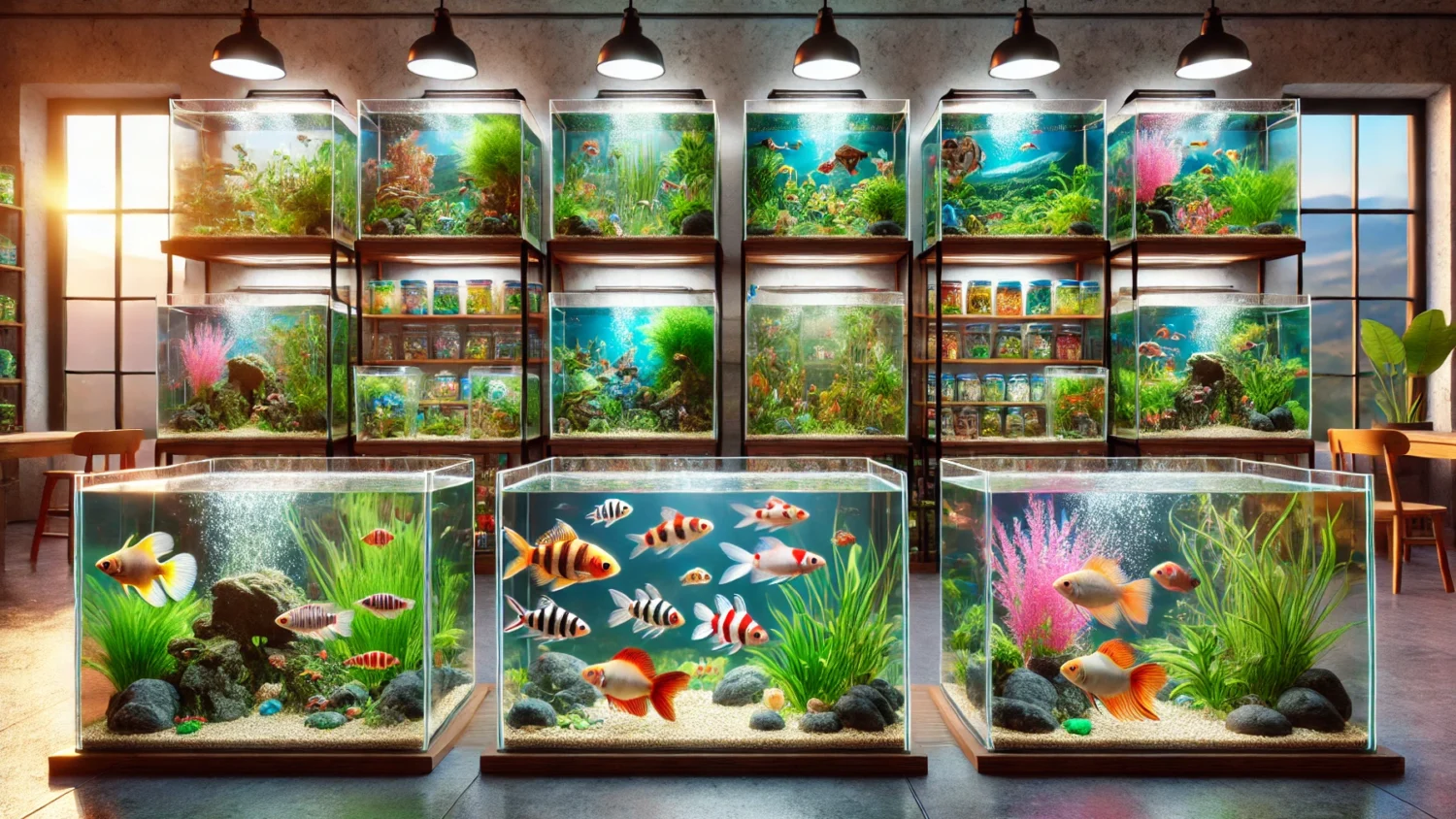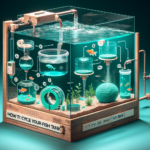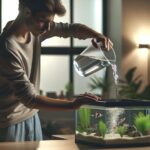Starting a freshwater aquarium is an exciting journey, made better with the right aquarium fish. Hardy fish are excellent choices for beginners because they can tolerate a range of water conditions, temperatures, and pH levels. They are less susceptible to stress and disease, reducing the risk of loss in a new aquarium setup. This makes them low maintenance fish and much easier to care for. This guide will introduce you to some of the best beginner fish for freshwater aquariums.
Why Start with Freshwater Fish?
Freshwater aquarium fish (also known as tropical fish for those that need warm water) are ideal for beginners due to their adaptability and the relative simplicity of maintaining their environment. They offer a diverse range of species, each with unique colors and behaviors, making it easy to create a vibrant and dynamic aquarium.
Key Qualities to Look for in Beginner Fish
When selecting fish for your first aquarium, consider the following traits:
- Hardiness: Fish species that can tolerate a range of water conditions are more forgiving of beginner mistakes.
- Peaceful Temperament: Non-aggressive species are easier to manage and are more compatible with other fish.
- Ease of Care: Species that have straightforward dietary and habitat needs simplify the effort on your end.
- Availability: Great beginner fish that are widely available and generally found at an affordable price.
Top 10 Best Freshwater Fish for Beginners

1. Zebra Danios (Danio rerio) – The Ultimate Hardy Fish for New Aquariums
Zebra Danios are small, active fish known for their resilience. They can survive in various water conditions and are less susceptible to common fish diseases, making them perfect for beginners. It also means that they are more compatible for community tanks, where other fish might have more specific water parameter requirements. Their energetic behavior adds life to any aquarium. They also come in a leopard pattern variety (Danio rerio var. frankei) which looks just as beautiful.

2. Guppies (Poecilia reticulata) – Colorful, Peaceful, and Easy to Care For
Guppies are vibrant and adaptable fish that reproduce easily, providing a dynamic and colorful display. They come in many different colour varieties, really brightening up the tank. They are a type of fish known as livebearers – which mean they will give birth to live babies (fry) rather than eggs. Providing a heavily planted tank is important if you want the baby fish to survive, else they might become a snack for other larger fish in the tank. Don’t worry, they reproduce quickly – making them a great beginner fish, quickly adding a lot of colour, movement and variety to the tank. They are peaceful and coexist well with other non-aggressive species. Guppies are also hardy, tolerating a range of water conditions.
The males are more colourful than the females. It’s okay to keep an all male tank for this visual preference. But, if keeping both male and female fish, make sure to keep a higher ratio of the females, else they can get over stressed by excessive attention.

3. Platies (Xiphophorus maculatus) – Friendly and Adaptable
Platies are known for their friendly nature and adaptability. They come in various colors and patterns, adding visual interest to your tank. Platies are also livebearers, meaning they give birth to live young, which can be fascinating to observe. Keep the same considerations in mind for the male-to-female ratio if keeping both in the tank. They are another hardy and gentle fish that works well in any community tank.

4. Betta Fish (Betta splendens) – Low Maintenance and Vibrant
Betta fish are renowned for their striking colors and flowing fins. They are relatively low maintenance and can survive in smaller tanks. The females have shorter fins, but can be just as beautiful in colour. Keep in mind that male Bettas are territorial, so only keep one to a tank to prevent aggression and fighting between males. This issue is less likely among the female betta, with many choosing to keep multiple in the same tank.
Some considerations with bettas, because of their large fins, they should not be kept with fish species that will nip at the fins, as this can cause damage and put your betta at risk of disease. They also prefer tanks with slower water movement, as it will be easier for them to get around.

5. White Cloud Mountain Minnows (Tanichthys albonubes) – Ideal for Unheated Tanks
These are small, peaceful fish that make excellent choices for beginner aquarists. Native to the cool mountain streams of southern China, they can tolerate a wide range of temperatures, from 15°C to 22°C (59°F to 72°F), making them also ideal for unheated tanks. Their shimmering metallic bodies, often with a “rainbow” sheen and red-tipped fins, bring vibrant color to any aquarium. Variations such as the “Golden White Cloud” and “Long-Fin White Cloud” add further variations to these colours.
Highly social, these minnows prefer schools of six or more, where their natural schooling behavior becomes more dynamic and engaging to watch. Their peaceful temperament allows them to coexist with other non-aggressive fish, making them great for community tanks. This species offers unique beauty and charm often overlooked in favor of more common tropical species.
![Corydoras Catfish (Corydoras X [many exist]) – The Gentle Cleanup Crew](https://zap.gdr.mybluehost.me/wp-content/uploads/2024/11/bb631ec4-ce77-459f-9fc5-f1a42220abf4.jpeg)
6. Corydoras Catfish (Corydoras X [many exist]) – The Gentle Cleanup Crew
Cory Catfish are bottom-dwellers that help keep your tank clean by scavenging for leftover food. They are peaceful, social, and prefer to be kept in groups (ideally 6 and above). Their gentle nature makes them great companions for other community fish. Again, they come in a range of different colours and patterns, some of which do need slightly different water temperatures and parameters – so do keep this in mind when selecting this species. The most common types found at fish shops are often the bronze, peppered and albino cory catfish. Do note that it is not recommended to keep multiple cory species in the same tank, as they can cross breed.

7. Neon Tetras (Paracheirodon innesi) – Beautiful and Beginner-Friendly Schooling Fish
Neon Tetras are small fish that prefer to live in schools. They are peaceful and get along well with other species. Known for their vibrant blue and red coloration, they add a stunning pop of color to any tank. Their iridescent blue stripe runs the length of their body, creating a captivating display as they swim in synchrony, particularly when kept in groups of six or more. They tend to sit middle-to-high in the water column and are a great addition to any tank. The striking blue flash down their sides adds for a beautiful colour display as the school swims about the tank.

8. Mollies (Poecilia sphenops) – Versatile and Hardy Freshwater Fish
Mollies are adaptable fish that can live in both freshwater and slightly brackish water. They are livebearers and, like guppies and platys, will easily reproduce in home aquariums. Mollies are generally peaceful and coexist well with other community fish. Again, they come in a range of colours. They have also been known to snack on some types of algae, so a worthwhile tank addition in my eyes!

9. Cherry Barbs (Puntius titteya) – Low Maintenance and Hardy
Cherry Barbs are small, peaceful fish that are easy to care for. Their bright red color, especially in males, makes them stand out in any aquarium, while the females have softer, lighter shades that add a nice balance when kept in groups. Cherry Barbs are less prone to disease and can tolerate a range of water conditions. As with many of the fish listed here, the cherry barb is a community fish and prefers being kept in groups of at least 6. These larger schools will bring out their personality and they’ll be more active and social in the tank.

10. Swordtails (Xiphophorus hellerii) – Active and Great for Community Tanks
Swordtails are active swimmers and can add lively movement to your aquarium. They are hardy and can adapt to various water conditions. Swordtails are also livebearers and can coexist peacefully with other community fish. Very similar in size to mollys and platys, but with an extended flare on their back tail that looks like a sword.
Here’s an overview table of the different parameters needed for each fish species. When starting out, it’s often easier to choose a fish that works for the stabilised parameters of your tank, rather than adjusting the water regularly to keep your fish happy. So, after you’ve finished cycling your tank make sure to conduct a broader water test of all of the parameters, to know which species to aim for. If your current water test kit does not include everything, you can always take a sample of your tank water down to your local fish shop. Most staff are more than happy to help you out and check your water parameters for free.
| Fish Species | Temperature Range (°C/°F) | pH Range | General Hardness (GH; dGH) | Carbonate Hardness (KH; dKH) |
|---|---|---|---|---|
| Zebra Danios | 18–25 °C (64–77 °F) | 6.5–7.5 | 5–12 | 5–12 |
| Guppies | 22–28 °C (72–82 °F) | 7.0–8.5 | 8–12 | 8–12 |
| Platies | 21–25 °C (70–77 °F) | 7.0–8.2 | 10–25 | 10–25 |
| Betta Fish | 24–27 °C (75–80 °F) | 6.5–7.5 | 3–5 | 3–5 |
| White Cloud Mountain Minnows | 18–22 °C (64–72 °F) | 6.0–8.0 | 5–19 | 5–19 |
| Corydoras Catfish | 22–26 °C (72–78 °F) | 6.0–7.8 | 2–12 | 2–12 |
| Neon Tetras | 21–27 °C (70–81 °F) | 6.0–7.0 | 1–2 | 1–2 |
| Mollies | 22–26 °C (72–78 °F) | 7.5–8.5 | 15–30 | 15–30 |
| Cherry Barbs | 23–27 °C (73–81 °F) | 6.0–7.5 | 5–15 | 5–15 |
| Swordtails | 22–26 °C (72–79 °F) | 7.0–8.3 | 12–30 | 12–30 |
From my experience, you can’t go wrong with one of the livebearer or danios species as your fish. They are colourful, energeticvery tolerant of beginner mistakes. Nevertheless, all the the fish listed above are easy go-to beginner fish, not only being tolerant with their water environment but also in the types of food they will eat. For community tanks, these fish will do just fine on flake or pelleted fish food. Most will also appreciate small variations in their diet, including some fresh vegetables, brine shrimp, or frozen blood worms once in a while.

Why I Don’t Recommend a Goldfish as a Beginner Fish
Goldfish might seem like the perfect pet fish for beginners, but they’re actually much harder to care for than most people think. Based on media representation, a lot of people believe goldfish can live in small bowls or tiny tanks, but that’s just not true.
Goldfish are messy eaters and create a lot of waste, which can make the water dirty really quickly. To account for this and keep them healthy, you’ll need a strong filter and a big tank. Ideally, each goldfish needs at least 75 liters (20 gallons) of water to have enough space. This means you won’t be able to add a lot of other fish with them, even though you have a big tank.
On top of this, you need to consider that goldfish prefer cooler water temperatures, between 18°C and 24°C (65°F to 75°F). This means that they can’t live with tropical fish that need warmer water. And so will restrict the types of species you can keep with them.
Another thing most people don’t know is how big and old goldfish can get. The largest goldfish recorded was over 50 cm (~20 inches) long and they live for 10 to 20 years if they’re properly cared for. That’s a big responsibility, especially if you’re just starting out in fishkeeping. When goldfish are kept in small tanks or bowls, they can get sick, stop growing properly, making for a very unhappy fish.
As discussed above, if you’re new to keeping fish, it’s better to start with species that are easier to care for, like Zebra Danios or Guppies. These fish are hardy, don’t need as much space, and are more forgiving if you make beginner mistakes.




